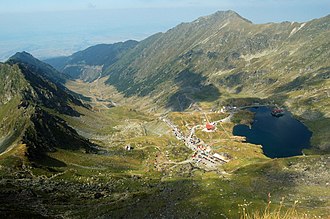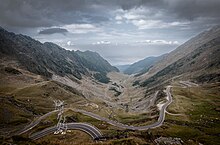Transfogarascher Hochstrasse
| Transfogarascher Hochstrasse (Bâlea Pass) | |||
|---|---|---|---|
|
View of the Transfogarascher Hochstrasse and Lake Bâlea |
|||
| Compass direction | north | south | |
| Pass height | 2042 m | ||
| circle | Sibiu | Argeș | |
| Watershed | Olt | Argeș | |
| Valley locations | Carțișoara | Curtea de Argeș | |
| expansion | Pass road | ||
| Built | 1970-1974 | ||
| Winter closure | November-June | ||
| Mountains | Fagaras Mountains | ||
| profile | |||
| Ø pitch | 4.7% (1455 m / 35 km) | 2.4% (1482 m / 61 km) | |
| Max. Incline | 8.6% (at km 30) | 8% (on km 20) | |
| Map (Romania) | |||
|
|
|||
| Coordinates | 45 ° 35 '54 " N , 24 ° 36' 59" E | ||
The Transfogarascher Hochstrasse ( Romanian Drumul Transfăgărășan or simply Transfăgărășan ) is a mountain road in Romania . The road connects the Argeș Valley in Great Wallachia with the Olt Valley in Transylvania , where it crosses the Făgăraș Mountains - a mountain range in the Transylvanian Alps . The Transfogarascher Hochstraße is part of the 151 kilometers (149.82 km) long, south-north running, national road (Drum național) DN 7C.
In the south, the national road DN 7C begins in the municipality of Bascov in the Argeş district , seven kilometers northwest of the city of Piteşti , where it branches off from its main route of national road 7 . Via Curtea de Argeș the road continues to Căpățânenii Ungureni , where the actual (according to various statements) 90.167 kilometers, or 117 kilometers long Transfogarascher Hochstrasse begins, and ends four kilometers after Cârțișoara in the Sibiu district at the confluence with the European road E 68 .
Route description
The Transfăgărăşan begins in Căpăţânenii Ungureni - part of the community Arefu - what they are that after about two kilometers hydropower plant dam Vidraru reached. From here the road begins to climb steeply and curvy in the valley of the Valea lui Stan stream, partly over viaducts and through four tunnels . Two of the tunnels are around 100 meters long and are located directly in front of the dam of the Vidraru reservoir. Here the Transfogarascher Hochstraße continues on the six meter wide and 307 meter long dam. After about 18 kilometers along the east bank of the reservoir, the road from the northern end of the reservoir runs a further 23 kilometers in the Capra Valley ( Valea Caprei ), initially gently, later winding and steep in a northerly direction. At an altitude of 2042 m , it crosses under the 2398 m high Paltinu , a mountain ridge of the Carpathians. The tunnel is 887 meters long with a six-meter-wide carriageway and a meter-wide sidewalk, and four and a half meters high. The so-called Bâlea Tunnel is the highest and longest tunnel in Romania. Here at the highest point of the route, the Argeș County borders the southern part of the Sibiu County . Immediately behind the poorly lit tunnel, the road reaches Lake Bâlea , where the hut of the same name ( Cabana Bâlea Lac ) is located.
From Lake Bâlea, the road winds in many serpentines in the Bâlea nature reserve ( Valea Bâlii ) down to Transylvania. The “Poarta Întâlnirii” ( Gate of Encounter ) rock breakthrough is located at a height of around 1600 m , the place where the north and south construction team met in 1974. A little further down at about 1200 m there is a second rock breakthrough, called “Poarta Geniştilor” ( Gate of the Pioneers ). The Transfogarascher Hochstraße continues past the Bâlea waterfall ( Cascada Bâlea ) to the town of Cârțișoara in the Sibiu district and after another four kilometers the elevated road ends at the confluence with the national road DN 1 - part of the European route 68.
A third of the route runs on the north side of the Fagaras Mountains and was the somewhat more difficult section for their construction. Because here in the Bâlea Valley occasionally low-hanging clouds obstruct the view, the Transfogarascher Hochstrasse is also known as the road in the clouds .
Overall, the road runs over (according to various statements) 830 or 833 bridges and 27 or 28 viaducts.
History and construction
Today's Transfogarascher Hochstraße was just a forest road and mountain path on both the north and south sides . As early as 1969, the repair of the path on the south side around the Vidraru Dam began. Road construction is said to have officially started on March 10, 1970. On behalf of the then head of state Nicolae Ceaușescu , the elevated road was supposed to serve a tourist purpose as well as a military purpose, caused by the tense relationship with the former Soviet Union after the events of the Prague Spring . The road connection over the high mountains was intended to enable rapid troop movements. After four and a half years of construction, the road was opened on September 20, 1974. Miners, construction workers and construction technicians were involved in the construction, the majority were soldiers from regiments 1 from Râmnicu Vâlcea and 52 from Alba Iulia . The construction of the road claimed numerous lives. Officials complain about 40 deaths; contemporary witnesses, on the other hand, name 400 dead at the Vidraru Dam, and others speak of 400 dead at the Bâlea Tunnel. A more precise number of fatalities due to the construction of the road is therefore unknown.
In honor of those who died during construction work, memorial plaques were placed at “Poarta Întâlnirii” and “Poarta Geniştilor”. These are damaged again and again.
The Transfogarascher Hochstrasse was for a long time the highest national road in Romania - in the Carpathians at all - until the 148-kilometer national road DN 67C, the so-called Transalpina , from Bercești (cadastral municipality of Novaci ) to Sebeș ( Mühlbach ) via Pasul Urdele ( 2145 m ), replaced the Transfogarascher Hochstrasse.
Leisure, tourism, sport
The Transfogarascher Hochstraße is the starting point for hikes to some of the peaks of the Fagaras Mountains. On the south side of the road, about 200 meters above the elevated road, near the Vidraru Dam hydropower plant, are the ruins of Poenari Castle .
The Vidraru Dam and Lake is a major attraction in the region. Leisure activities include boat trips on the lake, fishing (also in rented boats) and bungee jumps from the 166 meter high dam.
Above the dam is a statue that is supposed to represent Prometheus with lightning bolts in raised hands as a symbol for electricity, created by the sculptor Constantin Popovici in 1965.
On the north side of the Transfogarascher Hochstrasse, this leads through the Făgăraș Nature Park , the Bâlea and Arpășel Nature Reserves .
The Sibiu-Transfăgărăşan Motorsport Festival is held annually on the north side of the Transfăgărăşan .
gallery
Winter closure
The Transfogarascher Hochstraße is only fully passable for four months a year (July – October). In the period from November 1st to June 30th the road at the Bâlea Pass is impassable. The Bâlea lake can during this winter closure only from the north, from Bâlea waterfall made, by cable car can be achieved. On the south side, the Transfăgărăşan is only open to traffic up to kilometer 104 near Piscu Negru .
Web links
Individual evidence
- ↑ Official Gazette of Romania on the website of the Romanian Society for Motorways and National Roads ( memento of November 9, 2014 in the Internet Archive ) accessed on November 1, 2014 (Romanian)
- ↑ Ion Bratu: The Transfăgărășan, as it was from Journal of the Romanian Ground Forces, accessed on November 9, 2014 (Romanian)
- ↑ a b c d Information on Transfăgărășan at transfagarasan.info accessed on November 2, 2014 (Romanian)
- ↑ Map of the region on tenereclub.ro , accessed on November 5, 2014.
- ↑ World Database on Protected Areas - Valea Bâlii Nature Reserve (English)
- ↑ Elevation of the road, shown in a line diagram at salite.ch
- ↑ a b c Dan Gheorghe: Last construction workers on the Transfăgărășan , an interview with contemporary witnesses on August 11, 2008 at romanialibera.ro ( memento of January 24, 2010 in the Internet Archive ) accessed on November 7, 2014 (Romanian)
- ↑ Cristian Dumitrașcu, a 2008 interview with Nicolae Mazilu: The Riddle of Transfăgărășan at filmedocumentare.com Video on YouTube 20:51 min.
- ↑ Ioan Mocan: Weteran meeting at the "Poarta Geniștilor" in the Romanian Ground Forces magazine on July 2, 2009 at rft.forter.ro ( Memento from May 12, 2014 in the Internet Archive ) accessed on November 7, 2014 (Romanian)
- ↑ Web presentation of the Transalpina , accessed on November 9, 2014.
- ↑ Information from autorally.ro on December 19, 2013, accessed on November 9, 2014 (Romanian)
- ↑ Romanian Company of Motorways and National Roads: The TRANSFAGARASAN between Piscu Negru and Cabana Balea Cascada From 1 November 2014 closed until June 30, 2015 , press release on 30 October 2014 ( Memento of November 9, 2014 Internet Archive accessed) on the first November 2014 (Romanian)










